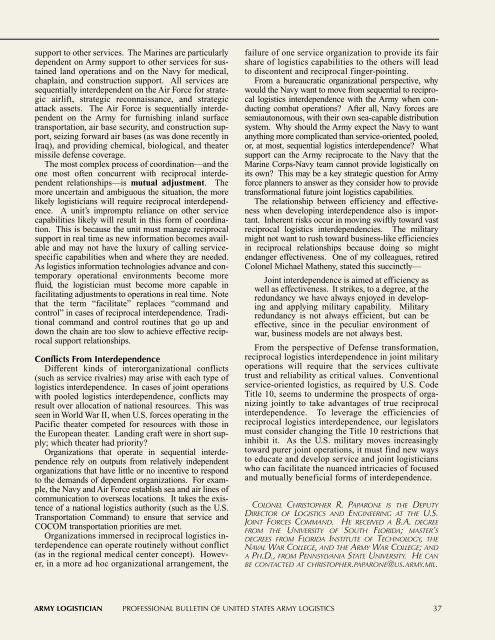Supporting the First Stryker Brigade in Iraq - Army Logistics ...
Supporting the First Stryker Brigade in Iraq - Army Logistics ...
Supporting the First Stryker Brigade in Iraq - Army Logistics ...
Create successful ePaper yourself
Turn your PDF publications into a flip-book with our unique Google optimized e-Paper software.
support to o<strong>the</strong>r services. The Mar<strong>in</strong>es are particularly<br />
dependent on <strong>Army</strong> support to o<strong>the</strong>r services for susta<strong>in</strong>ed<br />
land operations and on <strong>the</strong> Navy for medical,<br />
chapla<strong>in</strong>, and construction support. All services are<br />
sequentially <strong>in</strong>terdependent on <strong>the</strong> Air Force for strategic<br />
airlift, strategic reconnaissance, and strategic<br />
attack assets. The Air Force is sequentially <strong>in</strong>terdependent<br />
on <strong>the</strong> <strong>Army</strong> for furnish<strong>in</strong>g <strong>in</strong>land surface<br />
transportation, air base security, and construction support,<br />
seiz<strong>in</strong>g forward air bases (as was done recently <strong>in</strong><br />
<strong>Iraq</strong>), and provid<strong>in</strong>g chemical, biological, and <strong>the</strong>ater<br />
missile defense coverage.<br />
The most complex process of coord<strong>in</strong>ation—and <strong>the</strong><br />
one most often concurrent with reciprocal <strong>in</strong>terdependent<br />
relationships—is mutual adjustment. The<br />
more uncerta<strong>in</strong> and ambiguous <strong>the</strong> situation, <strong>the</strong> more<br />
likely logisticians will require reciprocal <strong>in</strong>terdependence.<br />
A unit’s impromptu reliance on o<strong>the</strong>r service<br />
capabilities likely will result <strong>in</strong> this form of coord<strong>in</strong>ation.<br />
This is because <strong>the</strong> unit must manage reciprocal<br />
support <strong>in</strong> real time as new <strong>in</strong>formation becomes available<br />
and may not have <strong>the</strong> luxury of call<strong>in</strong>g servicespecific<br />
capabilities when and where <strong>the</strong>y are needed.<br />
As logistics <strong>in</strong>formation technologies advance and contemporary<br />
operational environments become more<br />
fluid, <strong>the</strong> logistician must become more capable <strong>in</strong><br />
facilitat<strong>in</strong>g adjustments to operations <strong>in</strong> real time. Note<br />
that <strong>the</strong> term “facilitate” replaces “command and<br />
control” <strong>in</strong> cases of reciprocal <strong>in</strong>terdependence. Traditional<br />
command and control rout<strong>in</strong>es that go up and<br />
down <strong>the</strong> cha<strong>in</strong> are too slow to achieve effective reciprocal<br />
support relationships.<br />
Conflicts From Interdependence<br />
Different k<strong>in</strong>ds of <strong>in</strong>terorganizational conflicts<br />
(such as service rivalries) may arise with each type of<br />
logistics <strong>in</strong>terdependence. In cases of jo<strong>in</strong>t operations<br />
with pooled logistics <strong>in</strong>terdependence, conflicts may<br />
result over allocation of national resources. This was<br />
seen <strong>in</strong> World War II, when U.S. forces operat<strong>in</strong>g <strong>in</strong> <strong>the</strong><br />
Pacific <strong>the</strong>ater competed for resources with those <strong>in</strong><br />
<strong>the</strong> European <strong>the</strong>ater. Land<strong>in</strong>g craft were <strong>in</strong> short supply;<br />
which <strong>the</strong>ater had priority?<br />
Organizations that operate <strong>in</strong> sequential <strong>in</strong>terdependence<br />
rely on outputs from relatively <strong>in</strong>dependent<br />
organizations that have little or no <strong>in</strong>centive to respond<br />
to <strong>the</strong> demands of dependent organizations. For example,<br />
<strong>the</strong> Navy and Air Force establish sea and air l<strong>in</strong>es of<br />
communication to overseas locations. It takes <strong>the</strong> existence<br />
of a national logistics authority (such as <strong>the</strong> U.S.<br />
Transportation Command) to ensure that service and<br />
COCOM transportation priorities are met.<br />
Organizations immersed <strong>in</strong> reciprocal logistics <strong>in</strong>terdependence<br />
can operate rout<strong>in</strong>ely without conflict<br />
(as <strong>in</strong> <strong>the</strong> regional medical center concept). However,<br />
<strong>in</strong> a more ad hoc organizational arrangement, <strong>the</strong><br />
failure of one service organization to provide its fair<br />
share of logistics capabilities to <strong>the</strong> o<strong>the</strong>rs will lead<br />
to discontent and reciprocal f<strong>in</strong>ger-po<strong>in</strong>t<strong>in</strong>g.<br />
From a bureaucratic organizational perspective, why<br />
would <strong>the</strong> Navy want to move from sequential to reciprocal<br />
logistics <strong>in</strong>terdependence with <strong>the</strong> <strong>Army</strong> when conduct<strong>in</strong>g<br />
combat operations? After all, Navy forces are<br />
semiautonomous, with <strong>the</strong>ir own sea-capable distribution<br />
system. Why should <strong>the</strong> <strong>Army</strong> expect <strong>the</strong> Navy to want<br />
anyth<strong>in</strong>g more complicated than service-oriented, pooled,<br />
or, at most, sequential logistics <strong>in</strong>terdependence? What<br />
support can <strong>the</strong> <strong>Army</strong> reciprocate to <strong>the</strong> Navy that <strong>the</strong><br />
Mar<strong>in</strong>e Corps-Navy team cannot provide logistically on<br />
its own? This may be a key strategic question for <strong>Army</strong><br />
force planners to answer as <strong>the</strong>y consider how to provide<br />
transformational future jo<strong>in</strong>t logistics capabilities.<br />
The relationship between efficiency and effectiveness<br />
when develop<strong>in</strong>g <strong>in</strong>terdependence also is important.<br />
Inherent risks occur <strong>in</strong> mov<strong>in</strong>g swiftly toward vast<br />
reciprocal logistics <strong>in</strong>terdependencies. The military<br />
might not want to rush toward bus<strong>in</strong>ess-like efficiencies<br />
<strong>in</strong> reciprocal relationships because do<strong>in</strong>g so might<br />
endanger effectiveness. One of my colleagues, retired<br />
Colonel Michael Ma<strong>the</strong>ny, stated this succ<strong>in</strong>ctly—<br />
Jo<strong>in</strong>t <strong>in</strong>terdependence is aimed at efficiency as<br />
well as effectiveness. It strikes, to a degree, at <strong>the</strong><br />
redundancy we have always enjoyed <strong>in</strong> develop<strong>in</strong>g<br />
and apply<strong>in</strong>g military capability. Military<br />
redundancy is not always efficient, but can be<br />
effective, s<strong>in</strong>ce <strong>in</strong> <strong>the</strong> peculiar environment of<br />
war, bus<strong>in</strong>ess models are not always best.<br />
From <strong>the</strong> perspective of Defense transformation,<br />
reciprocal logistics <strong>in</strong>terdependence <strong>in</strong> jo<strong>in</strong>t military<br />
operations will require that <strong>the</strong> services cultivate<br />
trust and reliability as critical values. Conventional<br />
service-oriented logistics, as required by U.S. Code<br />
Title 10, seems to underm<strong>in</strong>e <strong>the</strong> prospects of organiz<strong>in</strong>g<br />
jo<strong>in</strong>tly to take advantages of true reciprocal<br />
<strong>in</strong>terdependence. To leverage <strong>the</strong> efficiencies of<br />
reciprocal logistics <strong>in</strong>terdependence, our legislators<br />
must consider chang<strong>in</strong>g <strong>the</strong> Title 10 restrictions that<br />
<strong>in</strong>hibit it. As <strong>the</strong> U.S. military moves <strong>in</strong>creas<strong>in</strong>gly<br />
toward purer jo<strong>in</strong>t operations, it must f<strong>in</strong>d new ways<br />
to educate and develop service and jo<strong>in</strong>t logisticians<br />
who can facilitate <strong>the</strong> nuanced <strong>in</strong>tricacies of focused<br />
and mutually beneficial forms of <strong>in</strong>terdependence.<br />
COLONEL CHRISTOPHER R. PAPARONE IS THE DEPUTY<br />
DIRECTOR OF LOGISTICS AND ENGINEERING AT THE U.S.<br />
JOINT FORCES COMMAND. HE RECEIVED A B.A. DEGREE<br />
FROM THE UNIVERSITY OF SOUTH FLORIDA; MASTER’S<br />
DEGREES FROM FLORIDA INSTITUTE OF TECHNOLOGY, THE<br />
NAVAL WAR COLLEGE, AND THE ARMY WAR COLLEGE; AND<br />
A PH.D., FROM PENNSYLVANIA STATE UNIVERSITY. HE CAN<br />
BE CONTACTED AT CHRISTOPHER.PAPARONE@US.ARMY.MIL.<br />
ARMY LOGISTICIAN PROFESSIONAL BULLETIN OF UNITED STATES ARMY LOGISTICS 37







